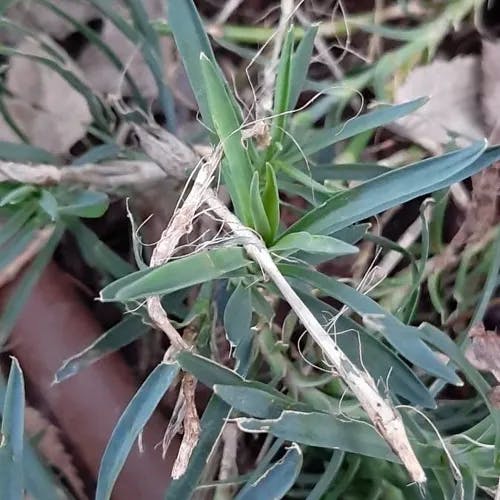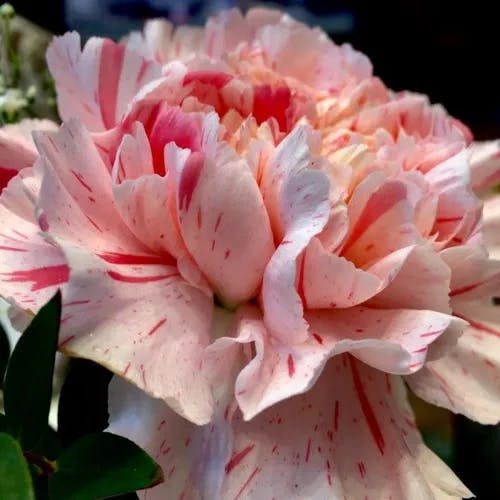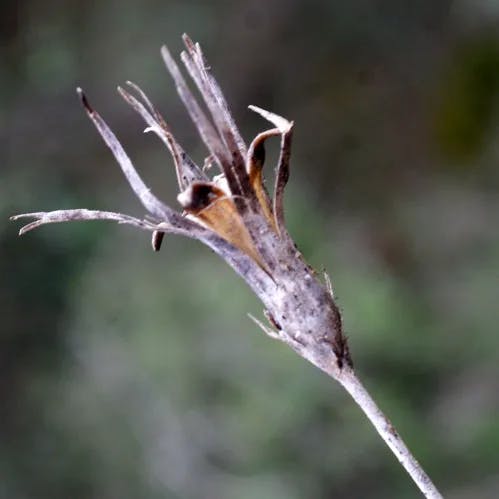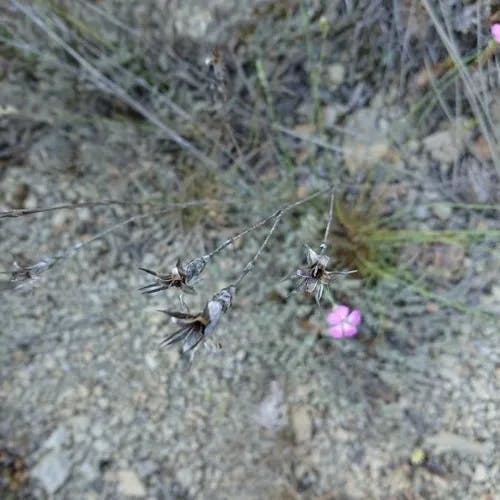The blooming plant known as the carnation or clove pink is presumed to have originated in the Mediterranean region. Its precise indigenous range is not known due to widespread farming over the past 2,000 years. This herbaceous perennial can reach 80 cm in height. The leaves are blue-green to grayish green, slender, and up to 15 cm long. The sweetly scented flowers are solitary or in clusters of up to five. They measure 3–5 cm across and were originally bright pinkish-purple, but cultivars in other hues like red, white, yellow and green have been bred. The fruit is a dry capsule containing many seeds. Growing Dianthus caryophyllus necessitates at minimum six hours of direct sunlight every day and loose, slightly alkaline soil. The plant cannot tolerate frost and requires protection in cold climates. Dianthus caryophyllus is a favored choice for gardens and flower arrangements. Its strong, spicy scent also makes it useful in perfumery. The bloom symbolizes love, fascination, and distinction. There are numerous varieties of Dianthus caryophyllus, including the common garden carnation, the greenhouse or florist's carnation, and the wild or clove pink. Each has unique traits and care needs. In terms of size, Dianthus caryophyllus typically reaches 24 to 36 inches tall, with a spread of 12 to 24 inches. Cultivating Dianthus caryophyllus is considered moderately straightforward, making it a good option for beginner gardeners. However, it does require regular watering, especially during dry spells, and prefers a sunny spot. Overall, Dianthus caryophyllus is a versatile and eye-catching plant with a long history of cultivation.
Carnation
- Common name
- Clove Pink
- Scientific name
- Dianthus caryophyllus
Basic Information
- Caryophyllaceae Family Dianthus Genus Carnation Species
- Caryophyllaceae > Dianthus > Dianthus caryophyllus
- 83%
- The Completeness of This Encyclopedia
Please help us complete the encyclopedia, Terrarium is a encyclopedia service to be completed with everyone in the world. Currently, this page is 83% complete. For more information on how to contribute, please click here.
- Flower
- Forb/herb
- Perennial
- Height
- 60cm ~
- Flower Color
- Leaf Color
- Anthesis
- spring, summer
- Sunlight Exposure
Full Sun Long hours of sunlight from morning to afternoon Partial Shade A location in the shade of a tree or where either the morning or afternoon is shaded Full Shade A place where there is no direct sunlight
- Full Sun
- Hardiness Zones
This is an indicator to know to which zone each plant can winter. Knowing the zone of each plant gives you an idea of the cold temperature resistance when grown in the ground without a roof. 2: -42.7 to -40.0 3: -39.9 to -34.4 4: -34.3 to -28.9 5: -28.8 to -23.3 6: -23.2 to -17.8 7: -17.7 to -12.2 8: -12.1 to -6.7 9: -6.6 to -1.1 10: -1.0 to 4.4 11: 4.5 to 10.0
- 6
- Cold resistance
- Fair
- Heat resistance
- Fair
- Habitat of origin
- Mediterranean region
- Growth Rate
- Normal
What is Carnation (Dianthus caryophyllus)?
What is Carnation (Dianthus caryophyllus)
Flower meaning
The frequent name for Dianthus caryophyllus is Clove pink. This blossom carries diverse symbolism in the idiom of flowers in America.The most regular understandings comprise captivation, individuality, and affection. For example, the symbol of fascination links with the flower's gripping fragrance and bright hues. Furthermore, Clove pink is the birth bloom for persons born on Jan 29th. This date-particular organization additionally improves the flower's weight in the idiom of flowers. Each of these senses leads to the abundant floral idiom encircling Dianthus caryophyllus.
Calendar of Carnation (Dianthus caryophyllus)
Calendar
The flowers of the Dianthus caryophyllus, also called Clove pink, are usually at their best in May and June. They give bright colors and a spicy scent like cloves. How long they bloom changes, but the plant usually needs 6-8 weeks from when it's planted until it flowers. To make it bloom longer, you should cut off the dead flowers. This makes the plant produce more flowers. Giving the plant full sunlight and soil that drains well also helps it bloom longer. Note that even though Dianthus caryophyllus can tolerate some shade, too much shade means fewer flowers and leggy growth. In cooler areas, it may keep blooming here and there through the summer and into fall. But in hot areas, it may stop blooming during the hottest summer weather and start again in fall.
How to grow Carnation (Dianthus caryophyllus)
Watering
The perennial plant species ornamentally recognized as Clove pink necessitates average irrigation. Through the seasons of plant growth, which begin in springtime and conclude in early autumn, saturate the complete depth of the earth surrounding the plant's roots just once the uppermost inch of topsoil feels parched to the touch. This typically translates to hydrating the plant one or two times per seven-day period, contingent on microclimate and dirt composition. In wintertime, lessen watering frequency to once per fortnight, or when the upper two inches of topsoil seem desiccated. Excessive hydration can catalyze decomposition of subterranean plant matter, thus effective drainage of the earth is imperative. The plant favors equally damp earth, nevertheless can withstand brief droughts. Refrain from wetting the leaves and stems, as this may spread fungal infestations. Rather, pour water at the plant's base, ideally at dawn, enabling any surplus water to evaporate as the day progresses. Keep in mind, the quantity and repetition of irrigation may require adjustments based on localized weather patterns and the overall vigor of the plant.
Soil and Fertilizer
The clove pink, also referred to as Dianthus caryophyllus, prospers in adequately drained, slightly alkaline terrain with a pH within 6.0 plus 7.5. The terrain ought contain abundant organic subject, however mustn't be extremely rich, since this could end in too foliage expansion to the detriment of blooms. A composed, delayed-discharge granular plant food (10-10-10) is suggested for Dianthus caryophyllus. Apply the plant food at planting period plus then each 4-6 weeks during the maturing time, subsequent the manufacturer's directions for the correct quantity. Keep away from over-fertilizing, since this could reason salt accumulation in the terrain, that is bad for the greenery. Within the fall, decrease fertilisation to enable the greenery to solidify off for winter. Sustaining the correct terrain circumstances plus appropriate fertilisation would guarantee healthy maturation plus abundant flowering of Dianthus caryophyllus.
Sunlight and Place
The perennial called the Clove Pink flourishes with six hours of sunlight per day. It survives freezing winter temperatures but avoids the midday sun in summer. Despite tolerance of temperature extremes, this plant needs drainage to prevent decay. Watering practices must accommodate both the heat of summer and the cold of winter for the Clove Pink. Good drainage keeps the roots healthy through heat waves and freezes. Place the Clove Pink accordingly to reduce sunburn potential. The morning sun suits it better than the afternoon sun during the summer months. In the winter, it tolerates the all-day sun. Although the Clove Pink withstands temperature swings, it thrives best around 60 to 70 degrees Fahrenheit. Avoid intense sunlight that overheats its leaves and blossoms. Give this plant at least six hours of sun daily for robust growth. Situate it where it gets sunlight in the morning and shade in the afternoon during the summer. The Clove Pink survives freezing winter temperatures with full sun exposure.
Advanced Information of Carnation (Dianthus caryophyllus)
Pruning
The optimal season for trimming the flower also known as pink carnation is early springtime when budding starts. Initially cut away any lifeless or infected branches all the way down. Subsequently, cut roughly 1/3 of the total height to stimulate bushy development. Be attentive to utilize pointy, sterilized shears to evade injuring the organism and disseminating sickness. Following clipping, irrigate thoroughly and administer a balanced fertilizer for new maturation. On a regular basis verify for indications of infestations or disease, notably after shearing. Keep in mind, appropriate shearing and care could substantially improve the wellness and form of your pink carnation.
Planting and Harvest
The pink flowered plant, also known as Clove pink, thrives when planted outside in the ground or inside in containers. When growing in pots, make sure the pot has good drainage. Fill the pot with a soil mixture that drains well. Put the pink blooming plant in the center of the pot, with the crown level to the top of the soil. After planting, water completely and put the pot where it gets full sun to partly shaded light. To repot, gently take out the plant from the current pot, loosen the root ball, and place it in a new pot filled with fresh soil. Water thoroughly after repotting. Avoid misformed growth by ensuring the plant is not crowded and gets adequate light. Regular trimming can also help keep the plant's shape and encourage flowering. Remember, the pink flowering plant prefers cooler temperatures, so avoid placing it in areas with extreme heat.
Propagation
The pink flower known as Dianthus caryophyllus has other names such as Clove pink. There are various ways to increase the number of these plants. One method is planting seeds in suitable soil and waiting for them to sprout. Another technique involves taking a piece of an existing plant during spring or summer, treating it with rooting hormone, and planting it so that it forms roots. A third approach is separating the roots and replanting the divisions when conditions are right in springtime. Each approach has advantages and disadvantages in terms of number of new plants and time required. Careful cutting of the flowers just before they bloom fully allows for attractive blooms indoors.
Pests and Diseases
The common clove pink flowering plant of genus Dianthus in the Caryophyllaceae family is predisposed to various insect pests and pathogen infestations. A prevalent bug is the greenfly, which can elicit the withering and expiration of the organism if not restrained. Greenflies extract the cell sap from the organism, enervating it and potentially introducing deleterious viruses. Periodic examination and application of soap-based insecticide or neem oil can promote management of greenfly populations. Another nuisance organism which can influence the common clove pink is the red velvet mite. These minute arachnids can generate significant impairment by extracting the organism's cell sap, resulting in yellowing foliages and stunted maturation. Intermittent misting of the organism and use of acaricides can promote control of red velvet mite infestations. The common clove pink is also prone to fungal illnesses such as Fusarium wilt and root decay. Fusarium wilt stimulates the withering and yellowing of the organism, eventually culminating in death. Root decay, frequently owing to overhydration, initiates the decomposition of the root organization. Both diseases can be circumvented by ensuring satisfactory drainage and avoiding overhydration. Bacterial leaf blight, an additional affliction impacting the common clove pink, produces dark blemishes on the foliages and can result in defoliation. It can be constrained by eliminating infected foliages and applying a copper-founded fungicide. In summary, periodic examination, suitable hydration, and the utilization of appropriate insecticides and fungicides can promote the health and freedom from pests and diseases of the common clove pink.
Habitat of Carnation (Dianthus caryophyllus)
Habitat
Toxicity of Carnation (Dianthus caryophyllus)
Health Benefits
- edible
- Inedible
- Toxic
- No toxicity
NO DATA
Toxic for dogs and cats
NO DATA
Q&A of Carnation (Dianthus caryophyllus)
- Is there a recommended way to choose Dianthus caryophyllus?
The perennial plant also referred to as Clove Pink has many varieties. When picking seeds or baby plants, think about the 'Grenadin' type if double blooms with a solid perfume are preferred. For a more packed plant appropriate for edges, choose the 'Chabaud' variety. If a long-lasting cut flower is desired, the 'Ideal Select' variety is a decent option. When buying seeds, confirm they are new, since older seeds may have a lower rate of germination. For seedlings, find healthy, green leaves and a well-formed root structure. Keep away from plants with yellowing leaves or indications of disease or pests. Select seedlings not yet blooming, as they will transplant better. Keep in mind, this plant favors full sunlight and drained soil, so ponder these elements when picking your plant.
- How Can You Incorporate Pink Clover Accessories into Your Decor?
The green perilla shrubs, or Perilla frutescens, contain properties which could supplement your style gracefully. Dehydrated perilla foliage within a container may centre your space, or weave into wreaths for rustic flair. The verdant hue of the perilla delivers lively accentuation. Imagine perilla motifs on cushions to invigorate a monotonous space. In addition, perilla artwork or dishware designs establish cohesion. However, restrain perilla, as dominance upsets harmony. Follow balance principles when interweaving perilla for optimum aesthetics.
- When Do Clover Pink Blooms Typically Occur?
The blooming period for scientifically termed Dianthus caryophyllus, more commonly called Clover Pink, typically occurs during the later part of spring and the early portion of summer. This window of flowering can show small differences based on the precise growing situations and weather in that area. With ideal conditions, this perennial plant may keep generating blooms over the summer and into the initial part of fall. It's notable that Clover Pink, similar to other perennial plants, needs a time period of cold dormancy during the winter which triggers the process of blooming. Therefore, in areas with mild winters, when and how much it blooms may change or be less predictable. In general, to promote a vibrant and healthy bloom, Clover Pink should be situated in soil that drains well and get sunlight to partial shade. Regular watering and occasional feeding with a fertilizer that is balanced can also improve the blooming time period.
- Can You Help Me Find a Solution to a Clove Pink Crossword?
Surely, I am able to help you with your crossword enigma. The clarification you are looking for, Clove Flower, is also acknowledged by its methodical appellation, Dianthus caryophyllus. This shrub is a breed of Dianthus, which is indigenous to the Mediterranean territory but has been cultured for centuries. It's renowned for its roseate florets and spicy scent, which is reminiscent of cloves. In the framework of a crossword enigma, the elucidation could be either Clove Flower or Dianthus. Contingent on the integer of squares and the specified indications, you might necessitate to employ one or the other. Recall, in crossword enigmas, the clarification must accommodate the integer of squares stipulated. So, if you possess a 9-square interstice, Dianthus would be the accurate clarification. If you possess an 8-square interstice, Clove Flower would be the accurate clarification. I aspiration this assists you explicate your crossword enigma. Felicitous puzzling!
- What Should You Know Before Buying a Pink Clover Bong?
Pink Clover Bong refers to numerous discolorations of Dianthus caryophyllus, or clove pink. This flower is recognized for its intense carmine blossoms and extraordinary perfume reminiscent of cloves. The Pink Clover Bong is an enduring biennial that flourishes in plentiful sunlight and well-depleted filth. It's additionally immune to prevalent flora afflictions and parasites, constituting it a carefree preference for both apprentice and seasoned planters. When procuring, investigate for greenery with vigorous, vibrant foliage and no indications of infection or parasite impairment. Furthermore, cogitate the plant's enormity and augmentation propensity, as certain varieties of Dianthus caryophyllus can develop moderately immense and may not be suitable for more diminutive plats or urns. Lastly, recollect that while the Pink Clover Bong is a biennial, it may not brave brutal winter circumstances without suitable assurance. Subsequently, it's indispensable to cogitate your neighborhood atmosphere and prepare accordingly to guarantee the plant's endurance and augmentation.











